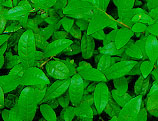

For several centuries Europeans drank tea without ever having seen a tea plant, because their traders were not allowed to travel inside China, the unique source of imported tea at that time. The first detailed study of tea published in Europe was written by Dr. Wilhelm ten Rhyne (1649-1700), a celebrated Dutch physician and botanist who also wrote the first account of acupuncture. He lived in the Dutch 'factory' (trading post) on the artificial island of Deshima in the harbor at Nagasaki from 1674 to 1676. His text on tea (written in Latin) was published in Danzig in 1678, as an appendix to Jacob Breyn's Exoticarum plantarum centuria prima (First Century of Exotic Plants). It seems never to have been translated into English.
Some years later, in 1683, the great German scholar Engelbert Kaempfer set out on a journey through Russia, Persia, Arabia and India. From there he took ship to Java, Siam, and finally Japan, where he too lived for a time on Deshima before returning to Europe in 1693. Kaempfer wrote his own account of Japanese tea to complement that of 'my much honored friend' ten Rhyne. It was published in the third fascicle of his Amoenitates Exoticae (Exotic Pleasures; 1712). An English version of this has recently been published, translated and edited by Robert W. Carrubba in The Library of Renaissance Humanism. It covers every aspect of tea growing, making, and brewing. Kaempfer's work in making Japan, and especially its botany, known in Europe, was hailed by the great botanist Linnaeus. The first edition of Linnaeus's Species Plantarum published in 1753 suggested calling the tea plant Thea sinensis, taking the Latin name for tea from Kaempfer.
Chinese tea was basically divided between green tea and black tea (often called bohea) in the European mind. A rather fanciful English writer of the mid-18th century, John Hill, declared in his Treatise on Tea (1753), quite without proof, that they came from different varieties of plant. Linnaeus in the second edition of his Species duly distinguished between Thea viridis (green) and Thea bohea (black). Neither Kaempfer nor Linnaeus seem to have suspected that there might be a link between Thea and the genus later named Camellia (after a Moravian Jesuit called Kamel who studied Asian plants).
It was only in the early 19th century that tea plants and seeds were obtained, after the English decided to challenge China's monopoly by trying to grow tea in India. Then it was found that in fact tea trees already grew wild, unrecognized, in the hills of Assam. A fierce debate raged as to whether these were identical with the Chinese variety, and whether Thea was a separate genus or part of the genus Camellia. It was finally settled by the International Code of Botanical Nomenclature in 1905 that the tea tree's correct name, no matter where it grows, is Camellia sinensis (L.) O. Kuntze. The tea tree is native to the whole monsoon area of southeast Asia: Thailand, Burma, southwest China, Assam.
Click to go on to the next page or to return to the index